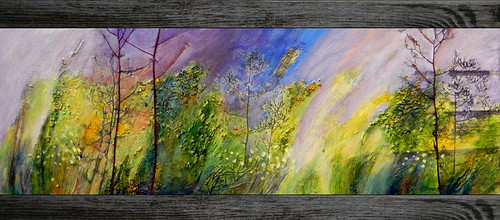Our third class in Mixed-Media Painting was about more ways to add texture in your mixed-media paintings via papers, foil, fabrics, organic materials, non-organic materials and tar gel.
This covered a huge amount of ground – many years later and I still haven’t had time to fully explore all the effects.
Paper
There are all sorts of papers to play with: rice paper, textured Japanese papers, newspaper, water colour paper, corrugated cardboard, handmade papers, tissue clothing patterns plus anything else you can dig out of your recycling box including old drawings and paintings that didn’t make the cut.
In the case of paper the way they are applied to the surface of the painting is mostly dependent on their fragility when wet.
Adding texture with tissue paper and other ‘fragile’ papers.
 Adding texture with Corrugated Cardboard, a ‘heavy’ paper.
Adding texture with Corrugated Cardboard, a ‘heavy’ paper.

Fabric
There are a ton of fabric textures as well, the most popular being cheesecloth, burlap and netted fabrics which can be glued to the painting surface with acrylic medium and the left as is or painted over.
This experiment is with cheesecloth that was painted over with acrylic.

Even More Ways to Add Texture to a Painting
In addition, our instructor Jeanne introduced tin foil, tar gel, and even real objects such as stones and plastic, and organic materials such as plants, leaves or dirt.
Real weeds applied to an acrylic painting.
 Detail of a different ‘weed’ painting.
Detail of a different ‘weed’ painting. Tar gel (aka String Gel) dripped down both panels of my scribble painting.
Tar gel (aka String Gel) dripped down both panels of my scribble painting. What an overwhelming class!
What an overwhelming class!

Inspiring. I might try this when I return from my travels.
My mixed media classes added a whole other dimension to my art that I hadn’t even known about!